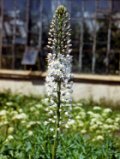 |
QUICK SEARCH
MO PROJECTS:
Africa
Asia/Pacific
Mesoamerica
North America
South America
General Taxonomy
Photo Essays
Training in Latin
America
MO RESEARCH:
Wm. L. Brown Center
Bryology
GIS
Graduate Studies
Research Experiences
for Undergraduates
Imaging Lab
Library
MBG Press
Publications
Climate Change
Catalog Fossil Plants
MO DATABASES:
W³MOST
Image Index
Rare Books
Angiosperm
Phylogeny
Res Botanica
All Databases
INFORMATION:
What's New?
People at MO
Visitor's Guide
Herbarium
Jobs & Fellowships
Symposium
Research Links
Site Map
Search
ORNAMENTAL PLANTS OF HORTICULTURE VALUESelection of perennials
E. aitchisonii Baker, 120-250, bright pink, April. New.
Most species are of great horticulture potential. They are very attractive. All have strap-like leaves in a rosette and a columnar inflorescence, a simple raceme that can reach up to 120-150 (250) cm. The flowers are sometimes very numerous, thus, for example, the E. aitchisonii inflorescence can contain 500 flowers, the E. candidus inflorescence may consist of 260 flowers, the E. olgae inflorescence (if fasciated) has 600 flowers and E. robustus can develop 1000 flowers in one inflorescence. Individual flowers 1.0-2.0 (3.0) cm in diameter. All species can be propagated by seed sown immediately after harvest. Some plants require 3 years before they come into flower, among them E. ambigens. Other species come into flower after 4 years. Among them are E. albertii, E. altaicus, E. bucharicus, E. fuscus, E. olgae, E. subalbiflorus and E. tadshikorum. A certain number of species can be easily propagated by division: E. hissaricus, E. pubescens, E. spectabilis, E. suworowii and E. turkestanicus. The roots, flat-spreading like a star from a small, hard crown (shortened stem), are fleshy and very brittle during the growing season. When transplanting and dividing one should be very careful. The best time for planting is late summer. For vegetative propagation each division should have roots and a part of the crown. Root cuttings without a part of the crown (stem) do not produce new buds. Vegetative propagation permits the production of flowering plants twice as fast as seed propagation. Almost all species require full sun and well-drained soil. Among the most attractive species are E. robustus and E. olgae. The first one prefers a semi shaded position and rich soil. The second, E. olgae, can grow on clayey soil and can be easily propagated. All species cannot grow in soils with excess moisture, especially in winter. Being representatives of the Central Asian region, most species are good for a warm dry climate: zones (5), 6, 7, etc. Some species can grow on dry, saline soil. They are E. inderiensis, E. kopetdaghensis, E. luteus, E. pubescens, E. roseolus and E. tadshikorum. Several very interesting ornamental hybrids can be found in nature, especially in the eastern regions of Tajikistan. Among them are: E. stenophyllus x E. olgae and E. stenophyllus x E. bucharicus. These plants have flowers of pink, salmon, orange and pink-lilac colour and a very large inflorescence. |
|||
| SELECTION OF PERENNIALS |
© 1995-2025 Missouri Botanical Garden, All Rights Reserved
4344 Shaw Blvd.
St. Louis, MO 63110
(314) 577-5100
Technical Support
